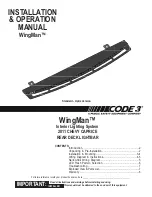
yellow
blue
6-30
Some driving conditions or climates may cause a brake
squeal when the brakes are first applied or lightly
applied. This does not mean something is wrong with
your brakes.
See “Caliper/Knuckle Maintenance Inspection” in
Section 7 of this manual under Part C “Periodic
Maintenance Inspections.”
Properly torqued wheel nuts are necessary to help
prevent brake pulsation. When tires are rotated, inspect
brake pads for wear and evenly torque wheel nuts in the
proper sequence to GM specifications.
Your rear drum brakes don’t have wear indicators, but if
you ever hear a rear brake rubbing noise, have the rear
brake linings inspected immediately. Also, the rear
brake drums should be removed and inspected each time
the tires are removed for rotation or changing. When
you have the front brake pads replaced, have the rear
brakes inspected, too.
Brake linings should always be replaced as complete
axle sets.
See “Brake System Inspection” in Section 7 of
this manual under Part C “Periodic
Maintenance Inspections.”
Brake Pedal Travel
See your dealer if the brake pedal does not return to
normal height, or if there is a rapid increase in pedal
travel. This could be a sign of brake trouble.
Brake Adjustment
Every time you apply the brakes, with or without the
vehicle moving, your brakes adjust for wear.
Replacing Brake System Parts
The braking system on a vehicle is complex. Its many
parts have to be of top quality and work well together if
the vehicle is to have really good braking. Your vehicle
was designed and tested with top
-
quality GM brake
parts. When you replace parts of your braking
system
--
for example, when your brake linings wear
down and you have to have new ones put in
--
be sure
you get new approved GM replacement parts. If you
don’t, your brakes may no longer work properly. For
example, if someone puts in brake linings that are wrong
for your vehicle, the balance between your front and
rear brakes can change
--
for the worse. The braking
performance you’ve come to expect can change in many
other ways if someone puts in the wrong replacement
brake parts.
Summary of Contents for 1999 LeSabre
Page 6: ...First Edition for Buick LeSabre Owner s Manual 1999 yellowblue vi NOTES...
Page 110: ...yellowblue 2 54 The Instrument Panel Your Information System...
Page 113: ...yellowblue 2 57 Gage Cluster...
Page 163: ...First Edition for Buick LeSabre Owner s Manual 1999 yellowblue 3 37 NOTES...
Page 164: ...First Edition for Buick LeSabre Owner s Manual 1999 yellowblue 3 38 NOTES...
Page 344: ...yellowblue 7 42 Maintenance Record DATE ODOMETER READING SERVICED BY MAINTENANCE PERFORMED...
















































